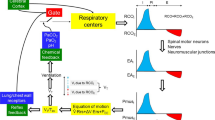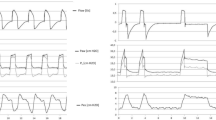Abstract
The control of breathing is an area of active research with important implications for the management of critically ill. The regulation of carbon dioxide occurs through a negative feedback control system involving peripheral and central chemoreceptors as well as effectors via the diaphragm and respiratory muscles. The interactions of the various sensors is a topic that is still debated, but the existing literature largely supports a hyper-additive model. Although the control system regulates arterial blood gases and work of breathing, it responds to many different perturbations including activity and lung function. Clinical implications important for the intensivist are discussed including mechanisms of dyspnea, worsening of hypercapnia during supplemental oxygen, patient–ventilator dyssynchrony. A thorough understanding of control of breathing is helpful for the intensivist and could be critical to the success of individualized therapy or personalized medicine in the ICU.
Access this chapter
Tax calculation will be finalised at checkout
Purchases are for personal use only
Similar content being viewed by others
References
Akoumianaki E, Lyazidi A, Rey N, Matamis D, Perez-Martinez N, Giraud R, Mancebo J, Brochard L, Richard JM. Mechanical ventilation-induced reverse-triggered breaths: a frequently unrecognized form of neuromechanical coupling. Chest. 2013;143:927–38.
Beall CM, Strohl KP, Blangero J, Williams-Blangero S, Almasy LA, Decker MJ, Worthman CM, Goldstein MC, Vargas E, Villena M, Soria R, Alarcon AM, Gonzales C. Ventilation and hypoxic ventilatory response of Tibetan and Aymara high altitude natives. Am J Phys Anthropol. 1997a;104:427–47.
Beall CM, Strohl KP, Blangero J, Williams-Blangero S, Decker MJ, Brittenham GM, Goldstein MC. Quantitative genetic analysis of arterial oxygen saturation in Tibetan highlanders. Hum Biol. 1997b;69:597–604.
Beitler JR, Sands SA, Loring SH, Owens RL, Malhotra A, Spragg RG, Matthay MA, Thompson BT, Talmor D. Quantifying unintended exposure to high tidal volumes from breath stacking dyssynchrony in ARDS: the BREATHE criteria. Intensive Care Med. 2016;42:1427–36.
Berngard SC, Beitler JR, Malhotra A. Personalizing mechanical ventilation for acute respiratory distress syndrome. J Thorac Dis. 2016;8:E172–4.
Dempsey JA. Exercise hyperpnea. Chairman’s introduction. Adv Exp Med Biol. 1995;393:133–6.
Dempsey JA, Forster HV, Birnbaum ML, Reddan WG, Thoden J, Grover RF, Rankin J. Control of exercise hyperpnea under varying durations of exposure to moderate hypoxia. Respir Physiol. 1972;16:213–31.
Dempsey JA, et al. Regulation of ventilation and respiratory muscle function in NREM sleep. Prog Clin Biol Res. 1990;345:145–54; discussion 154-145. available.
Dempsey JA, Veasey SC, Morgan BJ, O’Donnell CP. Pathophysiology of sleep apnea. Physiol Rev. 2010;90:47–112.
Duffin J, Mohan RM, Vasiliou P, Stephenson R, Mahamed S. A model of the chemoreflex control of breathing in humans: model parameters measurement. Respir Physiol. 2000;120:13–26.
Dunn WF, Nelson SB, Hubmayr RD. Oxygen-induced hypercarbia in obstructive pulmonary disease. Am Rev Respir Dis. 1991;144:526–30.
Esnault P, Cardinale M, Hraiech S, Goutorbe P, Baumstrack K, Prud’homme E, Bordes J, Forel JM, Meaudre E, Papazian L, Guervilly C. High respiratory drive and excessive respiratory efforts predict relapse of respiratory failure in critically ill patients with COVID-19. Am J Respir Crit Care Med. 2020;202:1173–8.
Feldman JL. Neurobiology of breathing control. Where to look and what to look for. Adv Exp Med Biol. 1995;393:3–5.
Feldman JL. Chapter 14--looking forward to breathing. Prog Brain Res. 2011;188:213–8.
Gattinoni L, Coppola S, Cressoni M, Busana M, Rossi S, Chiumello D. COVID-19 does not lead to a “typical” acute respiratory distress syndrome. Am J Respir Crit Care Med. 2020;201:1299–300.
Heinrich EC, Djokic MA, Gilbertson D, DeYoung PN, Bosompra NO, Wu L, Anza-Ramirez C, Orr JE, Powell FL, Malhotra A, Simonson TS. Cognitive function and mood at high altitude following acclimatization and use of supplemental oxygen and adaptive servoventilation sleep treatments. PLoS One. 2019;14:e0217089.
Hibbert K, Rice M, Malhotra A. Obesity and ARDS. Chest. 2012;142:785–90.
Horner RL. Motor control of the pharyngeal musculature and implications for the pathogenesis of obstructive sleep apnea. Sleep. 1996;19:827–53.
Horner RL. Impact of brainstem sleep mechanisms on pharyngeal motor control. Respir Physiol. 2000;119:113–21.
Horner RL. The neuropharmacology of upper airway motor control in the awake and asleep states: implications for obstructive sleep apnoea. Respir Res. 2001;2:286–94.
Horner RL. Pathophysiology of obstructive sleep apnea. J Cardiopulm Rehabil Prev. 2008;28:289–98.
Horner RL, Innes JA, Murphy K, Guz A. Evidence for reflex upper airway dilator muscle activation by sudden negative airway pressure in man. J Physiol (Lond). 1991;436:15–29.
Kikuchi Y, Okabe S, Tamura G, Hida W, Homma M, Shirato K, Takishima T. Chemosensitivity and perception of dyspnea in patients with a history of near-fatal asthma. N Engl J Med. 1994;330:1329–34.
Malhotra A, Schwartz DR, Ayas N, Stanchina M, White DP. Treatment of oxygen-induced hypercapnia. Lancet. 2001;357:884–5.
Manning HL, Schwartzstein RM. Pathophysiology of dyspnea. N Engl J Med. 1995;333:1547–53.
Mascheroni D, Kolobow T, Fumagalli R, Moretti MP, Chen V, Buckhold D. Acute respiratory failure following pharmacologically induced hyperventilation: an experimental animal study. Intensive Care Med. 1988;15:8–14.
Mathew OP. Maintenance of upper airway patency. J Pediatr. 1985;106:863–9.
Mathew OP, Abu-Osba YK, Thach BT. Influence of upper airway pressure changes on genioglossus and muscle respiratory activity. J Appl Physiol. 1982a;52:438.
Mathew OP, Abu-Osba YK, Thach BT. Genioglossus muscle response to upper airway pressure changes: afferent pathways. J Appl Physiol. 1982b;52:445.
Mead J, Takishima T, Leith D. Stress distribution in lungs: a model of pulmonary elasticity. J Appl Physiol. 1970;28:596–608.
Meza S, Younes M. Ventilatory stability during sleep studied with proportional assist ventilation (PAV). Sleep. 1996;19:S164–6.
Meza S, Mendez M, Ostrowski M, Younes M. Susceptibility to periodic breathing with assisted ventilation during sleep in normal subjects. J Appl Physiol (1985). 1998a;85:1929–40.
Meza S, Giannouli E, Younes M. Control of breathing during sleep assessed by proportional assist ventilation. J Appl Physiol (1985). 1998b;84:3–12.
Moosavi SH, Banzett RB, Butler JP. Time course of air hunger mirrors the biphasic ventilatory response to hypoxia. J Appl Physiol (1985). 2004;97:2098–103.
Moss M, Ulysse CA, Angus DC, National Heart L, Blood Institute PCTN. Early neuromuscular blockade in the acute respiratory distress syndrome. Reply. N Engl J Med. 2019;381:787–8.
Orr JE, Heinrich EC, Djokic M, Gilbertson D, Deyoung PN, Anza-Ramirez C, Villafuerte FC, Powell FL, Malhotra A, Simonson T. Adaptive servoventilation as treatment for central sleep apnea due to high-altitude periodic breathing in nonacclimatized healthy individuals. High Alt Med Biol. 2018;19:178–84.
Papazian L, Forel JM, Gacouin A, Penot-Ragon C, Perrin G, Loundou A, Jaber S, Arnal JM, Perez D, Seghboyan JM, Constantin JM, Courant P, Lefrant JY, Guerin C, Prat G, Morange S, Roch A, Investigators AS. Neuromuscular blockers in early acute respiratory distress syndrome. N Engl J Med. 2010;363:1107–16.
Plataki M, Sands SA, Malhotra A. Clinical consequences of altered chemoreflex control. Respir Physiol Neurobiol. 2013;189:354–63.
Robinson TD, Freiberg DB, Regnis JA, Young IH. The role of hypoventilation and ventilation-perfusion redistribution in oxygen-induced hypercapnia during acute exacerbations of chronic obstructive pulmonary disease. Am J Respir Crit Care Med. 2000;161:1524–9.
Simonson TS, Yang Y, Huff CD, Yun H, Qin G, Witherspoon DJ, Bai Z, Lorenzo FR, Xing J, Jorde LB, Prchal JT, Ge R. Genetic evidence for high-altitude adaptation in Tibet. Science. 2010;329:72–5.
Simonson T, Baker T, Banzett R, Bishop T, Dempsey J, Feldman J, Guyenet P, Hodson E, Mitchell G, Moya EA, Nokes B, Orr J, Owens R, Poulin M, Rawlings J, Schmickl C, Watters J, Younes M, Malhotra A. Silent hypoxemia in COVID-19. J Physiol (Lond). 2021:599(4);1057–65.
Skatrud JB, Dempsey JA. Interaction of sleep state and chemical stimuli in sustaining rhythmic ventilation. J Appl Physiol. 1983;55:813–22.
Skatrud JB, et al. A sleep-induced apneic threshold. Prog Clin Biol Res. 1990;345:191–9; discussion 199–200. available.
Smith JC, Ellenberger HH, Ballanyi K, Richter DW, Feldman JL. Pre-Botzinger complex: a brainstem region that may generate respiratory rhythm in mammals. Science. 1991;254:726–9.
Song D, Navalsky BE, Guan W, Ingersoll C, Wang T, Loro E, Eeles L, Matchett KB, Percy MJ, Walsby-Tickle J, McCullagh JSO, Medina RJ, Khurana TS, Bigham AW, Lappin TR, Lee FS. Tibetan PHD2, an allele with loss-of-function properties. Proc Natl Acad Sci U S A. 2020;117:12230–8.
Swenson ER. Hypoxia and its acid-base consequences: from mountains to malignancy. Adv Exp Med Biol. 2016;903:301–23.
Tobert D, Simon PM, Stroetz RW, Hubmayr RD. The determinants of respiratory rate during mechanical ventilation. Am J Respir Crit Care Med. 1997;155:485–92.
Tobin MJ. Basing respiratory management of COVID-19 on physiological principles. Am J Respir Crit Care Med. 2020;201:1319–20.
Tobin MJ, Laghi F, Jubran A. Why COVID-19 silent hypoxemia is baffling to physicians. Am J Respir Crit Care Med. 2020;202:356–60.
Younes M. The physiologic basis of central apnea and periodic breathing. Curr Pulmonol. 1989;10:265–326.
Younes M. Proportional assist ventilation. In: Mancebo J, Net A, Brochard L, editors. Update in intensive care and emergency medicine. New York: Springer; 2002. p. 39–73.
Younes M, Ostrowski M, Thompson W, Leslie C, Shewchuk W. Chemical control stability in patients with obstructive sleep apnea. Am J Respir Crit Care Med. 2001;163:1181–90.
Author information
Authors and Affiliations
Corresponding author
Editor information
Editors and Affiliations
Rights and permissions
Copyright information
© 2021 Springer Nature Switzerland AG
About this chapter
Cite this chapter
Moya, E.A., Simonson, T.S., Powell, F.L., Owens, R.L., Malhotra, A. (2021). Control of Breathing. In: Magder, S., Malhotra, A., Hibbert, K.A., Hardin, C.C. (eds) Cardiopulmonary Monitoring. Springer, Cham. https://doi.org/10.1007/978-3-030-73387-2_15
Download citation
DOI: https://doi.org/10.1007/978-3-030-73387-2_15
Published:
Publisher Name: Springer, Cham
Print ISBN: 978-3-030-73386-5
Online ISBN: 978-3-030-73387-2
eBook Packages: MedicineMedicine (R0)




